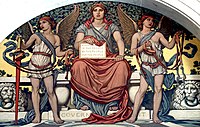
Photo from wikipedia
According to the Government of the Amur region, tax collection from the implementation of investment projects was tightly controlled from 2016, because of the region’s high debt load. This situation… Click to show full abstract
According to the Government of the Amur region, tax collection from the implementation of investment projects was tightly controlled from 2016, because of the region’s high debt load. This situation requires assessing the acceptability of the level of regional tax burden for business entities. The purpose of this paper is to develop a model for assessing the level of regional tax burden, taking into account the implementation of the largest investment projects in the territory. The main hypothesis of this paper consists, firstly, in the existence of tax burden, which is acceptable for regional economic entities. Secondly, this level of tax burden ensures the growth of fiscal revenues for the budget. We proposed to assess the level of tax burden on the basis of a three-factor linear heterogeneous production function, taking into account certain economic indicators of the largest investment project — “Construction of the Vostochny Ðiosmodrome†. The concept of the Laffer curve serves as a research methodology. According to our calculations, since 2011, the tax burden in the Amur region has a clear tendency to increase. At the same time, from 2007 to the present time, the tax burden exceeds its maximum permissible value and constrains economic growth in the region. If this trend continues, by 2018 tax revenues from the territory of the region will be on the verge of reduction. The obtained results show that the tax burden in the Amur region in 2017 is 16.81 %. To stimulate the activities of economic entities in the region, and as a consequence, to increase the GRP of the region, it is necessary to reduce the level of taxation by 4.77 percentage points (to 12.04 %), Thus, the current economic situation requires to change the course of regional taxation policy to a more liberal attitude towards taxpayers. Otherwise, soon the budget of the Amur region may fail to receive a part of revenues, as the region’s economic entities will not be able to meet their tax obligations in full and on time. The results of this study can be applied by the authorities of the Russian Federation and the Amur region for the development and adjustment of the main settings of tax policy.
Journal Title: Economy of region
Year Published: 2018
Link to full text (if available)
Share on Social Media: Sign Up to like & get
recommendations!